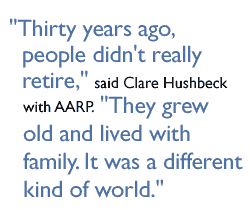NEW YORK (CNNfn) - You're just a few years from retiring and your savings are just a drop in the bucket. You've procrastinated long enough. Or you've tried to save but trying to map out a plan is overwhelming. And you've even sacrificed your own savings through the years to send your kids to college and to shower them with gifts.
Whatever the case, you need to put a plan together - now - because you know your Social Security benefits alone won't be enough for your retirement.
If you plan on retiring in the next five years, financial experts say you'll have to be aggressive and a bit creative. You probably won't end up lounging on a sandy beach or skiing in the Alps, but you can take steps to meet a retirement that's comfortable for you.
Retirement as a 'new' phenomenon
"Thirty years ago, people didn't really retire," said Clare Hushbeck, an economist with the American Association of Retired Persons in Washington. "They grew old and lived with family. It was a different kind of world."
Hushbeck said generous company pension plans were more the norm years ago. Older Americans are less familiar with 401(k)s and other retirement plans, since those savings options didn't become popular until the 1990s.
But today, you need to determine what kind of lifestyle you expect during retirement and map it out, said Lois Carrier, a certified financial planner and partner in Gilbert Carrier Maurice & Benzer in Greenville, Tenn.
She uses a "Rip Van Winkle" approach to retirement planning, telling her clients to "fall asleep and wake up ten years later," she said. "What would you like your life to be like?"
If you haven't saved a lick, traveling the globe might not be in the cards during retirement.
Not on Social Security alone
As you enter your golden years, you probably don't want to think about working longer than you have to. But if you continue to punch the clock a few more years, it may reap you more in Social Security benefits than if you retired immediately at the eligible age.
For example, full benefits are payable at age 65. People who delay retirement beyond 65 receive a special increase in their benefits when they do retire. However, if you take Social Security payments at 62, you receive only 80 percent of what you're eligible for.
So determine your expected monthly benefit by contacting the Social Security Administration.
Your Social Security benefit is determined by:
- your age at retirement
- your salary through the years
- your life expectancy
And you should note that under current Social Security administration rules, if you're between 65 and 69, you can work AND receive benefits.
However, if you earn more than $17,000 in a year, you lose $1 for every $3 of your benefits. For instance, if you continued to work at age 66 and earned $20,000, you would lose $1,000 of your annual benefit.
Both Republicans and Democrats have proposed legislation that would eliminate the salary cap altogether, allowing seniors to work without losing any Social Security benefits.

Your home as equity
You have sentimental ties to the home you've lived in for 30 years, but it may be time to reassess its value if you're short on savings for retirement.
Since a home you bought 30 years ago for $30,000 may be worth between $300,000 and $500,000 today, you may want to consider selling your house and moving into a less expensive residence with lower property taxes, suggests Scott Kahan, a certified financial planner and president of Financial Asset Management Corp. in New York City.
Investment options
So you're in the homestretch approaching retirement and you're just starting a 401(k) plan or an individual retirement account. How should you invest?
If you're planning on retiring in one year, Kahan recommends a balanced portfolio with a 50-50 mix of stocks and bonds. If retirement is two to five years off, shift that allocation towards equities with 70 percent in stocks and 30 percent in bonds, he says.
Some of the funds Kahan recommends include Marsico Growth and Income Fund (MGRIX), Dodge & Cox Balanced Fund (DODBX) and Invesco Select Income Fund (FBDSX).
A more aggressive approach would be a well-diversified equity portfolio with equal weightings of large, small and micro-cap growth stock funds, with smaller percentages in international funds like Japan and emerging markets, suggests Carrier, the financial planner in Tennessee.
"It sounds very risky and aggressive," she said, "but it's better than [allocating into] one class and shooting for the moon."
Although you've only just got the investing bug, you can take steps to secure a comfortable retirement.
"There's always hope," said certified financial planner Cal Brown in Manassas, Va. "Do the best you can with what you've got even if that means working longer or getting more aggressive in investments." 
|

